

| Invertebrate news 2015 |
| Insect and Arachnid news and sightings from around Nottinghamshire |
| A second Nottinghamshire site for Dahlica triquetrella | ||
| ..... | ||
| The entrance
to Newark Railway Station, hardly seems the place to
record something unusual, but turned up a second county
site for the moth Dahlica triquetrella, when
several occupied larval cases were discovered on November
1st. Dahlica triquetrella is currently rarer than both Dahlica lichenella and Dahlica inconspicuella and the only other known site in Nottinghamshire is the flood wall at Attenborough NR, where it was discovered new to the county by Richard Rogers, back in 2012. Although the larvae of all three Dahlicas produce very similar cases, those of Dahlica triquetrella are slightly larger (6mm-10mm) and covered with various insect fragments at the front end. If anything, Dahlica triquetrella cases are more similar to those of Diplodoma laichartingella, but less obviously triangular in cross section. |
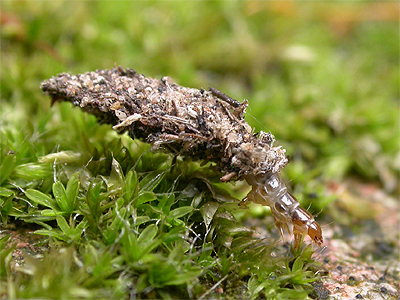 |
|
| The
Carabid Chlaenius vestitus found
away from the Trent Valley In late September, we found specimens of the attractively marked/coloured Ground Beetle Chlaenius vestitus, at the former sand quarry at Market Warsop. The four specimens were located underneath a flattened lager can, at the side of a small, semi-permanent flood pool, frequently driven through by off-road vehicles. The same location also prodiced Amara fulva, earlier in the year, another beetle of washed sand habitat. Despite being described as widescpread in southern counties of the UK, and with records as far north as Yorkshire, the majority of records fall in a line just south of Nottingham, running in a line from The Wash to the Severn Estuary. Chlaenius vestitus is not a common beetle in Nottinghamshire. The few known sites are in the Trent Valley. |
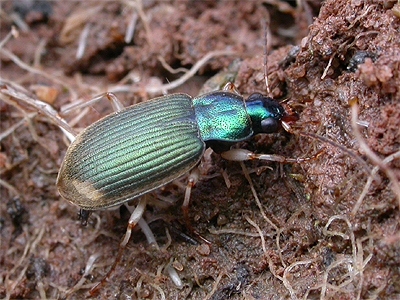 |
|
| Empicoris
culiciformis in Nottinghamshire In early 2015, Attenborough Nature Reserve's Reserve Manager Tim Sexton found and photographed an Empicoris sp, which was later identified as being Empicoris culiciformis and the first ever record for the county. There are just three species of Empicoris in the UK, with Empicoris vagabundus being the most common. Empicoris culiciformis is extremely uncommon in the UK, with records scattered across the middle of the country and with none previously reported from Nottinghamshire. |
| High numbers of Hummingbird Hawk-moths move through Nottinghamshire | ||
| .... | ||
| High
numbers of Hummingbird Hawk-moths - resulting from eggs
laid by moths arriving during June, have been passing
through Nottinghamshire during a notable period of
migration. Peak dates so far have been from September 7th to 13th, but another wave of moths began to appear from September 18th. We recorded numerous different individual Hummingbird Hawk-moths, which could be identified through a combination of wear, size and markings via photographs. Numbers peaked with five on September 10th and four on September 11th. The total number of recorded visits for each day was 23 and 20 respectively. We were able to devote virtually complete coverage on September 10th, 11th and later September 19th, to the moths visiting the Valerian growing in our Market Warsop garden. This enabled us to gather some interesting data on the duration of visits by feeding moths. |
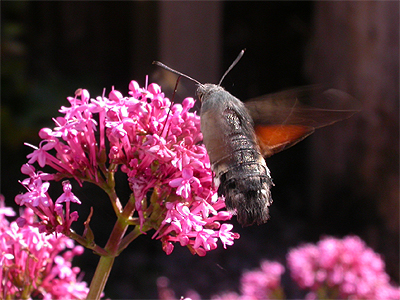 |
|
| .... | |||||||||||||||||||||||||||||||||||||||||||||||||||||||||||||||||||||||||||||||||||||||||||||||||||||||||||||||||||||||||||||||||||||||||||||||||||||||||||||||||||||||||||||||||||||||||||||||||||||||||||
|
|
||||||||||||||||||||||||||||||||||||||||||||||||||||||||||||||||||||||||||||||||||||||||||||||||||||||||||||||||||||||||||||||||||||||||||||||||||||||||||||||||||||||||||||||||||||||||||||||||||||||||||
| .... | |||||||||||||||||||||||||||||||||||||||||||||||||||||||||||||||||||||||||||||||||||||||||||||||||||||||||||||||||||||||||||||||||||||||||||||||||||||||||||||||||||||||||||||||||||||||||||||||||||||||||||
| One of the two moths
recorded on September 18th was worn and very distinctive
(M1) and visited our garden at 13 Day Street at 18:08h.
The other moth (M2) came in at 18:51h and was in perfect
condition. Both fed for a number of minutes, before
presumably flying off to roost nearby. On the morning of September 19th, M2 appeared on the rear wall of the house and remained for over an hour (from 09:00h - 10:18h) before flying down to feed for four minutes at 10:19h. It left and was not seen for the rest of the day and presumed gone. M1 arrived to feed at 10:05h for four minutes, before returning at 10:24h for a further four minutes. It then developed a pattern of feeding/resting for the rest of the day. At one point it rested on the rear wall of 16 Day Street, then later rested on the fence of 12 Day Street. |
|
||||||||||||||||||||||||||||||||||||||||||||||||||||||||||||||||||||||||||||||||||||||||||||
| .... | |||||||||||||||||||||||||||||||||||||||||||||||||||||||||||||||||||||||||||||||||||||||||||||
| The general
pattern of this individual moth from late morning
onwards, was seven feeding visits of between 10min to
18min duration, followed by periods of inactivity lasting
between 1h:02m and 1h:58m. It flew off to roost at 18:40h
and returned the following morning (September 20th) at
09:47h. There were two morning feeds each lasting 14
minutes, with resting periods spent on our house wall.
During the afternoon, M1 came in a further four times to
feed and was joined by a second smaller individual, but
feeding times were below ten minutes. It is hoped that Hummingbird Hawk-moths migration continues throughout September and that additional feeding data can be obtained. |
|||||||||||||||||||||||||||||||||||||||||||||||||||||||||||||||||||||||||||||||||||||||||||||
| Stomorhina
lunata recorded
at Langold 2015 seems to have been a good year for the rare and distinctively marked migrant Calliphorid Stomorhina lunata, with a number of UK records. Stomorhina lunata specialises in predating the eggs of Locusts. Of African origin, it has been widely recorded in many counties of the UK during 2015, including both male and female, found and photographed by Pauline Bradford at her home in Langold on September 20th 2015. It is unknown whether there are any previous Nottinghamshire records. |
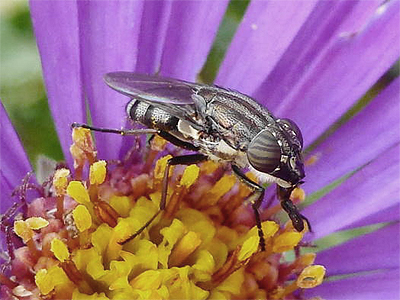 |
|
| Latest
news on the Harvestman Leiobunum sp.A,
at Worksop Priory Our first visit of 2015 took place on August 2nd, which was a week earlier than in 2014. A total of 217 Leiobunum sp.A were counted, with many still immature, although there were already a few mature males present. Once again, the main aggregations were located in exactly the same positions on the Priory walls, as recorded in previous years. |
||
| .... | ||
| The largest single
aggregation consisted of approximately 90 individuals,
but higher than normal numbers were present on the
eastern (recorded for the first time on the new section
of the Priory) and the northern side. One immature male,
was even found underneath the overhanging top stone of a
grave and away from the main Priory walls. Our second visit took place on August 15th. A total count of 212 was made, with groups in similar positions and there was an increase in the numbers of small groups. One usually guaranteed aggregation under an arch on the eastern-end of the Priory had disappeared. We returned to Worksop again on September 4th, noting changes to the distribution of Leiobunum sp.A on the north side of the Priory and actually finding very few to be present. Most were found on the warmer southern walls, probably moving as a result of the recent spell of cold northerly winds. |
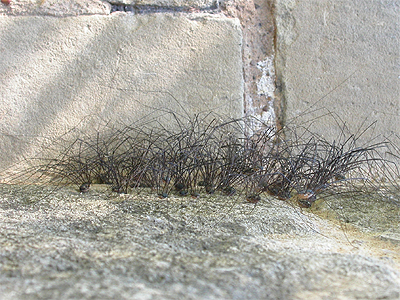 |
|
| .... | ||
| A final total
of 159 was disappointing, but a check of an adjacent
stone building proved worthwhile, with a further 54 Leiobunum
sp recorded. Final total for the visit was 213, so
amazingly similar counts for all three visits this year
so far. On September 14th, we returned with wildlife cameraman James Dunbar to conduct another count. On arrival we immediately checked the first aggregation, which only a few weeks ago had held approximately 90 individuals. With the division of this aggregation noted on our previous visit, we noted a further reduction in numbers and after checking all the southern walls of the Priory, concluded that many Leiobunum had dispersed further afield, including one group which had aggregated on the north side of a large tomb. No Leiobunum were found to be present on the Priory's eastern side and there were very few recorded along the northern side. Clearly there was a large reduction in numbers and possibly a more widespread dispersal away from the Priory. A total of 116 Leiobunum sp were found on the Priory and another 28 on an adjacent building, which had reduced in number from 54 on our previous visit. We continue to be convinced that there are other sites in Worksop for Leiobunum sp.A, but have had no success so far. The housing estate where we first recorded this Harvestman back in 2009, was also surveyed again. |
||
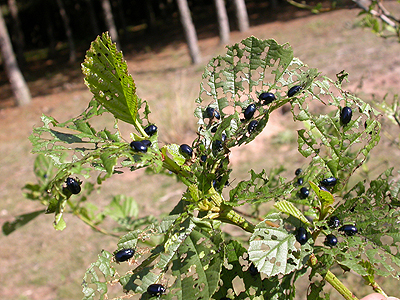 |
Huge
numbers of Alder Leaf Beetle at Manton Pit Wood The Alder Leaf Beetle (Agelastica alni) has continued to find former Colliery sites in north Nottinghamshire, very much to their liking. But on a recent visit to the former Manton Colliery (now Manton Pit Wood) we were stunned at the vast numbers of beetles present. Our most conservative estimate was of 2,500 beetles, but we believe this to be very much an under-estimate. Virtually every Alder present, held good numbers, including young sucker growth. The beetles were also recorded on both Birch and Goat Sallow. |
|
| First
Nottinghamshire record of the Centipede Cryptops
anomalans Entomologists Keith and Belinda Lugg, visiting Worksop Priory to see the large Harvestman Leiobunum sp, also discovered Nottinghamshire's first record of the nationally scarce (Nb) Centipede Cryptops anomalans, in the grounds of Worksop Priory on August 22nd 2015. The record provides a welcome addition to the county's species list and is a species we have personally searched for on a number of occasions. |
||
| Platytes alpinella - another new moth for Nottinghamshire | ||
| .... | ||
| An example of Platytes
alpinella (Crambidae), attracted to a light
trap operated by Phil Cadman and Ian Hunt of the Lound
Moth Group in August 2015, has recently been confirmed as
being the first record for Nottinghamshire. Mainly a coastal species of south-eastern parts of the UK, Platytes alpinella does occasionally turn up inland and has been recorded just outside Nottinghamshire, in both Lincolnshire and South Yorkshire (at Rossington in 1997 and West Melton in 1999). Derbyshire's first record was from near Chesterfield in 1990. Phil and Ian recorded their first Platytes alpinella, at a Robinson 125MV light run at Chainbridge Meadows August 11th 2015 and have since recorded a second moth from nearby Neatholme Lane on August 20th. Both locations form part of the Nottinghamshire Wildlife Trust's Idle Valley NR. |
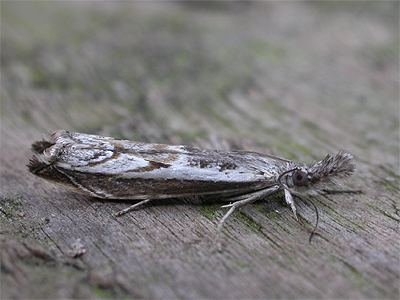 |
|
| Isophrictis
striatella - confirmed as a new
moth to Nottinghamshire An hour spent netting moths on a section of the former Warsop Main Colliery on August 17th, provided what proved to be a Nottinghamshire first, when an adult Isophrictis striatella (Gelechiidae) was found nectaring on the flowerheds of Tansy. This moth is mostly restricted to the south-east of the UK, but is occasionally found at isolated sites further north. At the time of writing (August 2015) the current status of this moth in Nottinghamshire has been researched and the county micromoth recorder Dave Budworth, has confirmed that there are no records for both Nottinghamshire and neighbouring Derbyshire. However, another search a few evenings later, proved that Isophrictis striatella is well established on site and is likely to be present at many Nottinghamshire sites. |
||
| Scarlet
Tiger - a first Nottinghamshire record At the beginning of July and coinciding with a period of very hot weather, a Scarlet Tiger (Callimorpha dominula) was trapped at MV light by David Yates in his Southwell garden. The county recorder has confirmed that there are no previous Nottinghamshire records, but raised the possibility that the moth could have been captive bred and released. However, in view of the genuine migration which occurred around the capture date, this is almost certainly a genuine wild record. |
||
| The
Leaf Beetle Chrysomela aenea at
Warsop Main Pit Top A potential first Nottinghamshire record of the attractive, green Leaf Beetle Chrysomela aenea, has been recorded on the site of the former Warsop Main Colliery. With no records (recent or otherwise) showing on the NBN Gateway, the chance find of a single adult climbing towards the top of a small Alder in late June 2015, may well be the first Nottinghamshire record. Chrysomela aenea appears to be widespread over much of the north-west UK, so may well be increasing its south-easterly range, in much the same way as Agelastica alni (the Alder Leaf Beetle) has done in the past few years. |
||
| June brings numbers of migrant moths to Nottinghamshire | ||
| .... | ||
| At the end of May, we
reported a lack of migrant moths, but that they were
expected to arrive during June. Perhaps the most expected
of the less common migrants was Bordered Straw (Heliothis peltigera) and we eventually recorded our
first ever on June 20th 2015. We recently recieved news of a another Bordered Straw, trapped at MV light in Bestwood village by Sean Tobin on June 25th. More are clearly on the way later this Summer. June ended with us recording our highest ever June total of over 100 Silver Y's. Most were recorded either nectaring at Valerian or trapped at MV light in our garden at Market Warsop. Hummingbird Hawk-moths also provided a record June count, with 15 different individuals recorded on Valerian at Market Warsop between 8th and 18th. Other migrants recorded, included Rush Veneers at Langar (9th) Market Warsop (16th) and Lound Wood, near Eakring (19th), with Plutella xylostella recorded on both 19th and 25th. |
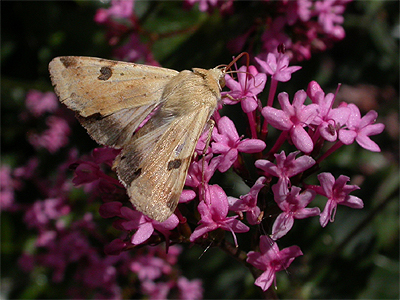 |
|
| Argyresthia
cupressella - a new moth for
Nottinghamshire A small Argyresthia species, attracted to MV light operated in our Market Warsop garden on June 13th 2015, turned out to be Argyresthia cupressella and a new moth for Nottinghamshire. Confirmation later came from the county recorder Dave Budworth. Originally a North American species, Argyresthia cupressella is found in the UK after being introduced here via the horticultural trade. It was first recorded in Suffolk as recently as 1997 and there are records as far west as Wales, but very few from Midland counties. Despite the lack of records, this moth is probably widespread in many urban and suburban areas of Nottinghamshire. A second specimen was trapped on June 17th. |
||
| May
2015 - migrant moths on their way It looks as though 2015 might be a classic year for migrant moths, following a string of early arrivals in the south of the UK. Bordered Straw (Heliothis peltigera) has arrived early in good numbers and has already been recorded from several light traps operated in the Midlands. |
||
| .... | ||
| Huge numbers of Bordered
Straw and other migrants are reportedly on the Continent
and its nine years since it was last recorded in
Nottinghamshire, back in the last big migrant year of
2006. Prior to that, the only other recent Bordered Straw
records are from two on the same night at different
Newark sites in 2003. Good numbers of Silver-striped Hawk-moth (Hippotion celerio) have also reached the UK and this is another moth likely to occur in Nottinghamshire for the first time in many years, later this Summer or Autumn. So far though, 2015 has been poor for migrant moths locally and we have not recorded any migrants at all this year to date (May 31st) and even regular moths such as Silver Y and Plutella xylostella, have failed to turn up at the MV light operated from our Market Warsop home, as of the end of May. |
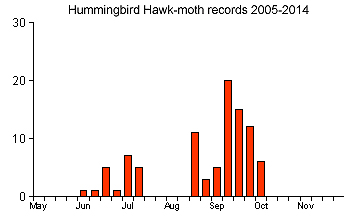 |
|
| .... | ||
| As we are just into June at the time of writing, we are watching the Valerian in the garden at every available opportunity for the first Hummingbird Hawk-moth of the year. We have recorded 95 Hummingbird Hawk-moths in Nottinghamshire since 2005, with many of these in our own garden. The accompanying graph produced from our records, shows that the first of these can usually be expected to arrive in June and early July. Peak numbers of return migrants, move through from mid-August through to the first week of October. | ||
| Some
recent south Nottinghamshire invertebrate records We recently conducted several Grizzled Skipper surveys at a brownfield site near Langar in the south of Nottinghamshire. The survey also produced casual records of a number of notable county invertebrate species, including the Lygaeid Bug Eremocoris podagricus, Sehirus luctuosus (Forget-me-not Shieldbug) and Oedemera nobilis (Swollen-thighed Beetle). |
||
| .... | ||
| Eremocoris podagricus
(right) has a south-easterly range in the UK and with
just two traceable Nottinghamshire records. It was first
recorded at nearby Barnstone in 1985 and there seems to
have been no further records since. Usually found within the vicinity of Forget-me-not (Myosotis arvensis), Sehirus luctuosus is a ground living Shieldbug and is a difficult species to locate, spending the day low down underneath vegetation. Presently classed as rare in Nottinghamshire, as far as we are aware, we found the county's only other record at Warsop Main Pit Top in May 2007. Oedemera nobilis is more commonly known as the Swollen-thighed Beetle and for obvious reasons. A recent Nottinghamshire colonist, this beetle has been spreading north through the UK and is known from at least two Trent Valley sites. It must now be quite common in south Nottinghamshire and is an easy species to record. The adults are regular visitors to flowers (especially Ox-eye Daisy) and are conspicuous by their quite large size and metallic green colouration. |
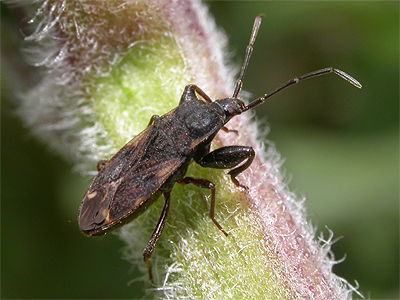 |
|
| A rare Nottinghamshire record of the Spitting Spider Scytodes thoracica | ||
| .... | ||
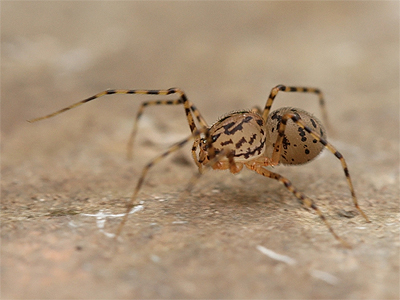 |
Tim Sexton
has reported on what could be Nottinghamshire's second
record of the Spider Scytodes thoracica, from
his Attenborough home. But it was Tim's son Jake, who
actually found the Spider in the bathroom sink. Often known as the Spitting Spider, due to its method of catching prey items, Scytodes thoracica is a spider of the southern half of the UK. It is found in heated buildings and houses, in which it wanders during the night. Females mesure 4-6mm in length, with the males slightly smaller. In Nottinghamshire, Scytodes thoracica certainly seems to be rare or just under-recorded and we know of just one previous record from somewhere in south-west Nottingham (via the Spider Recording Scheme website) but have no details or actual site. Our thanks go to Tim for kindly providing us with this excellent photograph. |
|
| Coleophora juncicolella - a new moth for Nottinghamshire | ||
| .... | ||
| This small Coleophorid
was not known to have previously occurred in
Nottinghamshire before, but it was suggested to us by
Martin Gray (the county moth recorder for south
Lincolnshire) that we look for the larval cases of Coleophora
juncicolella, a few days after he had recently
recorded Lincolnshire's first record on April 10th 2015. On April 18th, we decided that we would try for this moth on Budby South Forest and within half an hour, had swept two small larval cases from the Heather. The Nottinghamshire and Derbyshire county micromoth recorder Dave Budworth reports that "it looks to be a first for Notts". He notes that J.W. Carr does not mention the species, although there could well be a later record lurking somewhere. MOGBI shows a record from Notts but this may be difficult to trace. On checking the Derbyshire records, Dave was surprised to find very few, with only one for last century from the Goyt Valley in 1956 by the late Hugh Michaelis. He says, "there are a group of more recent Derbyshire records, but these are again all along the western moorland border of the county. |
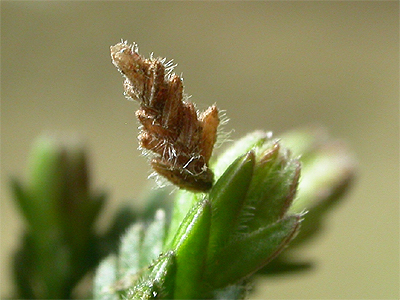 |
|
| .... | ||
| This latter distribution is essentially the result of the efforts of Steve Hind, but it is strange that it has not been reported from the central region of the county. Likewise one would have expected records from the heathlands of Notts over the years". | ||
| Another
county record of the
Longhorn Beetle Pogonocherus hispidus Adrian Dutton reports that he recently recorded a possible third county record of the attractive Pogonocherus hispidus, swept from low vegetation at a site between Shelford and Radcliffe on Trent, on April 14th 2015. In our recently published 'The current status and distribution of Nottinghamshire Longhorn Beetles' (available via the downloads page), we state that there are just two previous Nottinghamshire records. It was recorded from Bunny Old Wood (no recorder given) in 2000 and more recently from the Nottingham Trent University's Brackenhurst Campus, near Southwell in 2014 (Heeney, W.). |
||
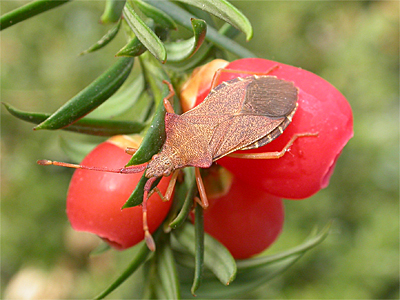 |
Box
Bug reaches Nottinghamshire A general increase in interest in recording Nottinghamshire's invertebrate fauna, is continuing to see new species being recorded in the county for the first time. Tim Sexton is leading the wa in the south of the county, recently discovering Box Bug (Gonocerus acuteangulatus) at Attenborough NR in April. Formerly recorded as an RDB1 species and only from Box Hill in Surrey, Box Bug has rapidly increased it's range to cover large parts of the south-eastern UK. It reached Leicestershire for the first time in 2014, so its occurrence in Nottinghamshire was to be expected. Now found on a variety of trees and shrubs, Tim found and photographed this individual on Cherry. More records should follow in the coming years. |
|
| Another
Nottinghamshire record of the Alder Leaf Beetle We recently received news of another Nottinghamshire record of Alder Leaf Beetle (Agelastica alni) from the former Shireoaks Pit Top in the north-west of the county. Cliff Toplis recorded this large and attractive leaf beetle on April 6th 2015, providing Nottinghamshire with a quick third record, following records from Dyscarr Wood in June 2014 (Pauline Bradford) and Warsop Main Pit Top by ourselves in September 2014. |
||
| The
first confirmed record of Geophilus
carpophagus for Nottinghamshire Geophilus carpophagus has frequently been confused with Geophilus easoni in the past, and only recently have the two been considered to be separate species (Arthur, et al 2001). There is a previous Nottinghamshire record from Bunny Old Wood, but the recorder is unknown and Geophilus carpophagus is not a woodland species, favouring more urban locations where it can be found under loose mortar and brickwork on the walls of buildings etc. Two specimens were found underneath loose mortar on the walls of Sookholme Church in April 2015 and represent the first confirmed record of this Centipede in Nottinghamshire. |
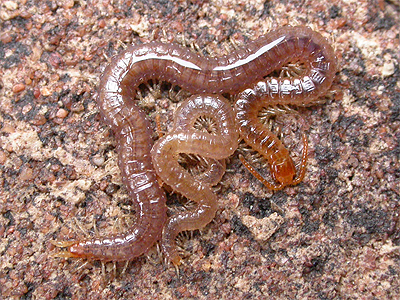 |
|
| A
second Nottinghamshire record of the Woodlouse
Porcellio spinicornis While conducting further searches for Bristly Millipede (Polyxenus lagurus) on Edwinstowe and Cuckney Churches, we discovered the distinctive Woodlouse Porcellio spinicornis, underneath loose mortar. Others were found, but all were considerably smaller than this adult. There seems to be just one previous Nottinghamshire record, of what should be a common species of buildings and stone walls etc, found listed on the NBN Gateway from West Bridgford in 1975. |
||
| Choneiulus palmatus - a new Millipede for
Nottinghamshire Whist searching for Bristly Millipedes on an old stone wall at Church Warsop, three unidentified Millipedes were found underneath loose mortar. Later examination, proved that they were Choneiulus palmatus, which had not been recorded in Nottinghamshire previously, but has been recorded in neighbouring Leicestershire and Rutland. As with most Myriapods, this is a difficult Millipede to identify to species level and Choneiulus palmatus is impossible to separate from Proteroiulus fuscus and Nopoiulus kochii, without the aid of a microscope. It seems very much a Millipede of buildings and urban sites, but this was still a surprise find and a first county record. |
||
| Recent
Nottinghamshire records of the Bristly Millipede On March 27th, we decided to check the walls of our local Parish Church for invertebrates. One of our target species this year, is the Bristly Millipede (Polyxenus lagurus), which has been found to be common on the walls of many Leicestershire and Rutland Churches, but Nottinghamshire records are rare. |
||
| .... | ||
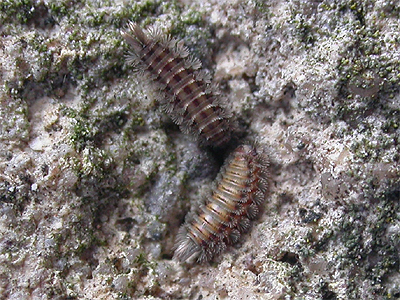 |
There was very little to
be found on the Church itself, so we turned our attention
to the stone walls just over the road. A few minutes of
searching provided very little, but then we struck lucky,
finding several probable Bristly Millipedes. A hand lens
soon proved that they were indeed Bristly Millipedes. On one small peice of mortar were five Bristly Millipedes of varying sizes, with the smallest being approximately 1mm long. They move quite quickly, so proved a little difficult to photograph, but they eventually settled down. At the time, we thought this was the first Nottinghamshire record for just over a century, but it has turned out that there are two previous records for Attenborough NR, tracked down on the NBN Gateway. We're sure that we had checked before compiling our recent publication "An Atlas of Nottinghamshire Millipedes" a few months ago. |
|
| .... | ||
| Even the British Myriapod and Isopod Group (who very kindly sent us all their Nottinghamshire records) had no records for Bristly Millipede from Nottinghamshire in their database. We are led to believe that it has already been recorded from Attenborough Church in early 2015. | ||
| A
fifth county record of Juniper Shieldbug Dave McGeever recently sent us a record of Juniper Shieldbug (Cyphostethus tristriatus) found on a fence in his Ravenshead garden on March 21st 2015, which seems to be only the fifth county record to date. Although Juniper Shieldbug still seems to be a rare Shieldbug in Nottinghamshire (based purely on the current lack of records) this distinctive species has spread north through the UK, over the past number of years and must certainly be in all Nottinghamshire towns by now. Saying that, it did take us nearly ten years to find, eventually turning up in Mansfield, where we found numerous nymphs on Lawson's Cypress. |
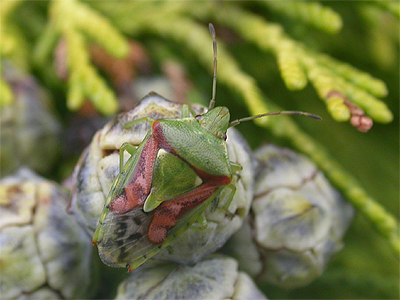 |
|
| An
early first Red Admiral record for 2015 Warm sunny weather produced an unusually early Red Admiral record, when an adult was recorded on the walls of our Market Warsop house on February 18th. Our earliest-ever first date for Red Admiral, is of an adult seen flying across the road near Tug Bridge Farm, Eakring on February 9th 2008. |
||
| Chordeuma
proximum - a new Millipede for
Nottinghamshire In early January 2015, we discovered an immediately different looking Millipede, to any which we had recorded before. It was found under an old piece of carpet, dumped along a former railway line, which used to access the Clipstone Colliery. |
||
| .... | ||
| Underneath the same
carpet, were singles of Blaniulus guttulatus
and the compulsory Cylindroiulus punctatus, both
Millipedes we find regularly. Just its very habit, was enough to make us suspect that it was something different, so we took many photographs while on site, but took it home to try and get photographs of better quality and in better natural light. Thankfully, photographs took at the time, plus those on return home, were enough to help us realise that this was indeed an interesting find and certainly a Millipede at least new to us. It measured approximately 13mm and the resulting photographs enabled us to key it out as a Chordeuma species, of which there are two in the UK. Both Chordeuma sylvestre (C.L.Koch, 1847) and Chordeuma proximum (Ribaut, 1913) are known to have strong south-westerly distributions in the UK and are visually identical, but the most likely species based on its wider UK range alone would be Chordeuma proximum. |
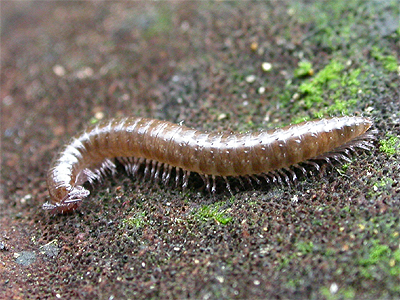 |
|
| .... | ||
| Later examination under the microscope, confirmed that our Millipede was indeed a male Chordeuma proximum and an obvious first record for Nottinghamshire, coming only a couple of weeks after we had published our Modern Atlas of Nottinghamshire Millipedes. | ||
| .... | ||
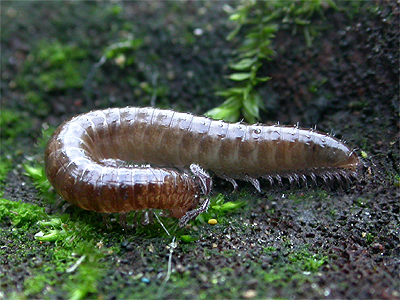 |
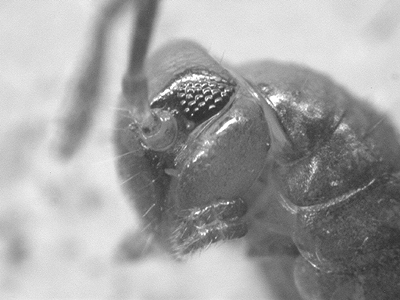 |
|